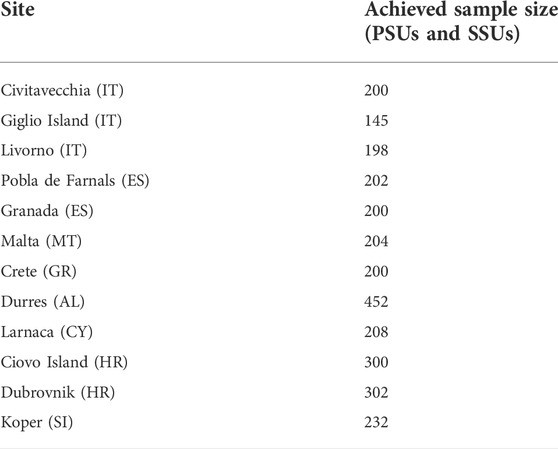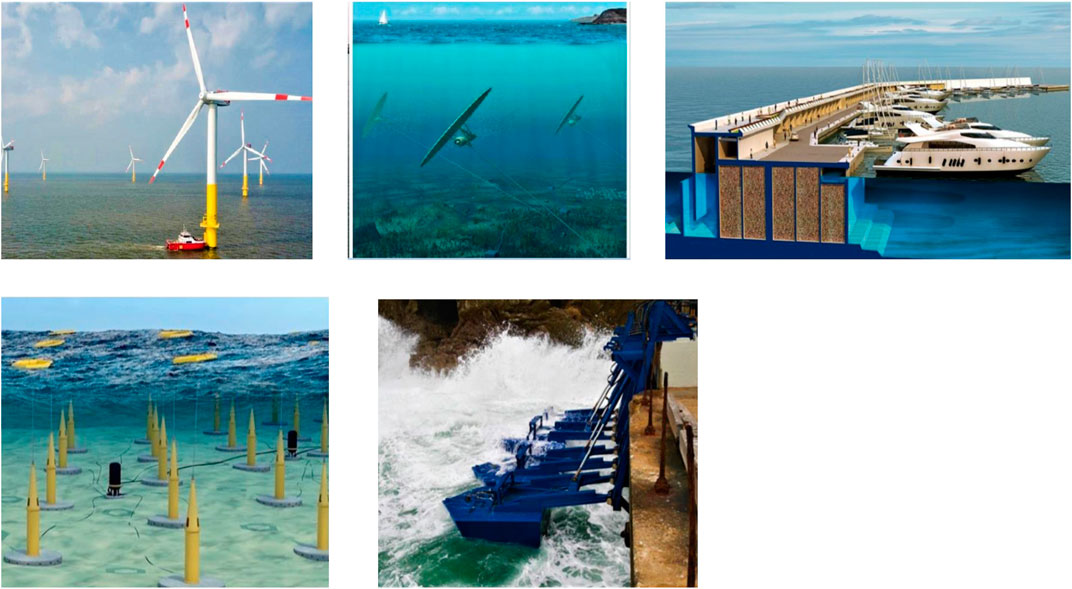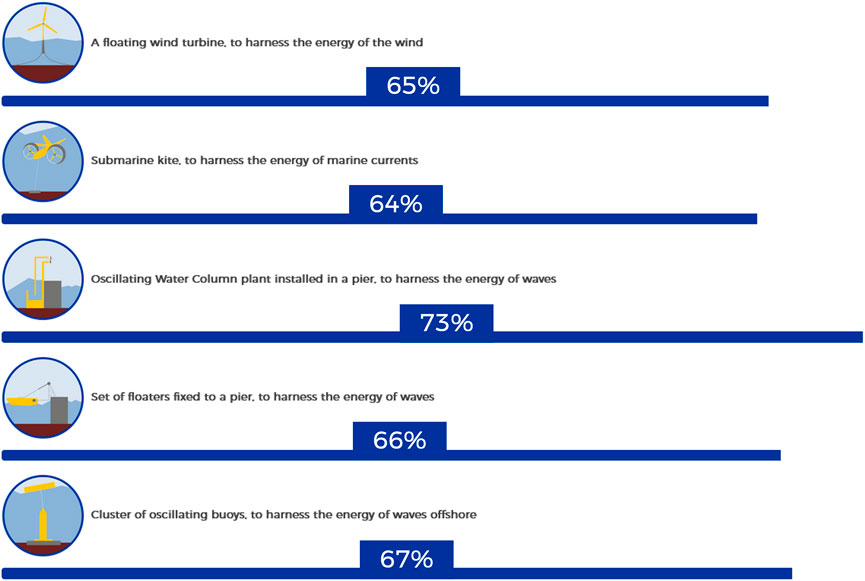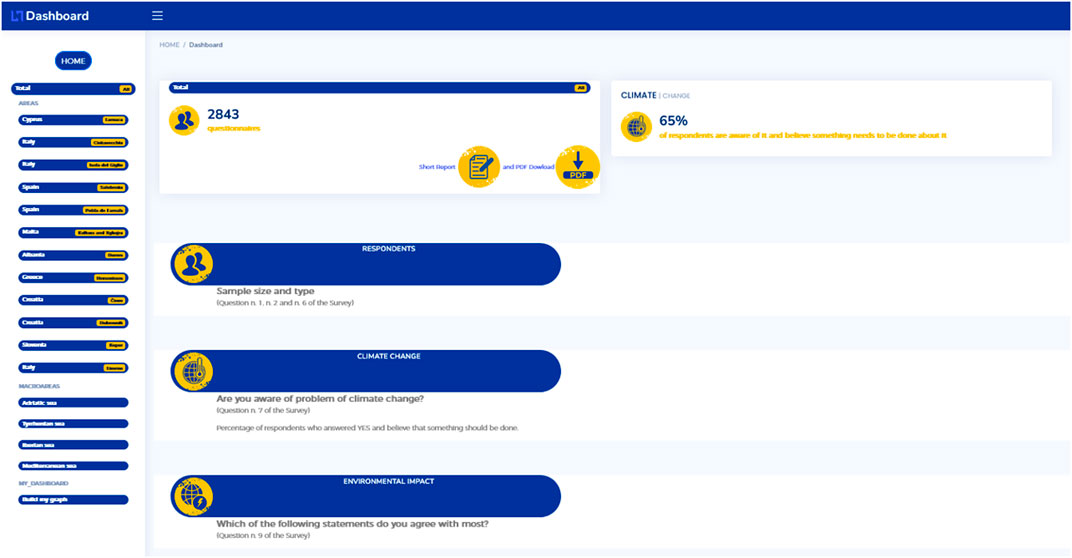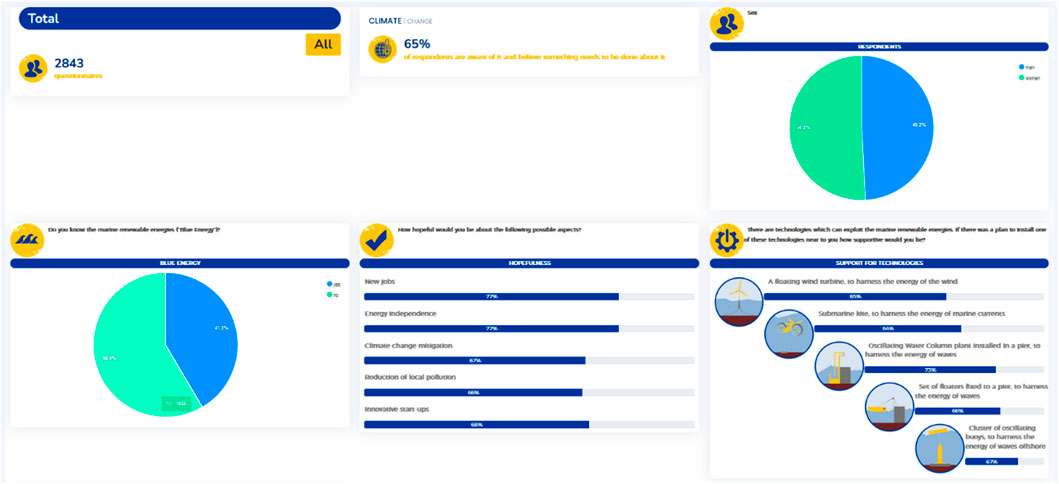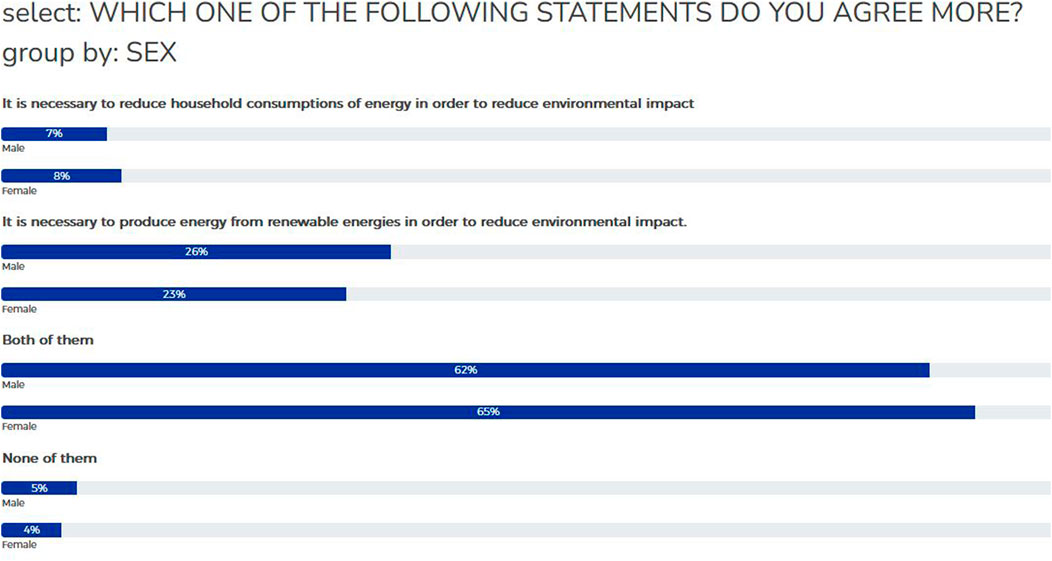- 1Department of Economics and Statistics, University of Siena, Siena, Italy
- 2Ecodynamics Group, Department of Earth, Environmental and Physical Sciences, University of Siena, Siena, Italy
An energy transition is needed in order to meet the European pledge of reaching climate neutrality by 2050. This transition cannot ignore the renewable resources available from 70% of the Earth (namely, the oceans and seas). This concept is fundamental for the planet, especially for the Mediterranean area. Marine renewable energies are still under-deployed in the Mediterranean area for many reasons, including legislative constraints, lower energy availability, and technological readiness. An appropriate participatory process including all actors (e.g., policymakers, firms, citizens, and researchers) is necessary for a correct path toward decarbonization. The BLUE DEAL project was conceived and implemented by 12 Mediterranean partners to tackle these issues and set the route for blue energy deployment in the Mediterranean area. Activities already conducted include a survey to probe the perceptions and attitudes of citizens toward blue energy. The survey targeted about 3,000 persons in 12 Mediterranean sites with the aim of bringing citizens into the discussion on future technologies. The results showed that although blue energy is still relatively unknown to the general public (only 42% of respondents were aware of these technologies), there was a general willingness (70%) to host one or more such installations in their areas. Here, we describe our survey method and some empirical results with suggestions for replicability and recommendations on how to use it for policymaking purposes.
1 Introduction
Renewable energy, in particular the deployment of marine renewable energy, is a key to fighting climate change. In November 2020, the European Commission issued an “EU Strategy to harness the potential of offshore renewable energy for a climate-neutral future” (EC, 2020). This strategy lays the foundations for replacing fossil fuels with offshore renewables, thus creating industrial opportunities and green jobs across the continent. It recognizes the fundamental role that seas and oceans can play in EU decarbonization due to their untapped potential as clean energy sources. It underlines that the marine renewable energy industry will need to grow by a factor of five by 2030 and a factor of 25 by 2050 to sustain the goals of the Green Deal (EC, 2020). The readiness of renewable energy technologies to offer variegated alternative solutions is gradually improving (see for example Gilani et al., 2021; Shoeibi et al., 2021; Shoeibi et al., 2022a; Shoeibi et al., 2022b; Dhivagar et al., 2022). The same path, coupled with broad stakeholder involvement, should be followed by so-called blue energy to become a viable solution and be considered in coastal energy planning.
A sustainable blue economy is, therefore, critical for achieving the goals of the European Green Deal (EC, 2019a) and securing a green and inclusive recovery from the pandemic. This was recognized by the adoption of a new EU sustainable blue economy strategy in May 2021, entitled “transforming the EU’s blue economy for a sustainable future.” The strategy sets the agenda for the transformation needed in the whole bioeconomy sector and for the integration of the blue economy in the Green Deal (EC, 2021).
Seventy percentage of the Earth’s surface is sea and ocean. In order to meet EU targets and become carbon neutral by 2050, marine energy production is necessary. The marine renewable strategy can be a stepping stone for the energy transition. Energy independence is also important for local community development since it eases and promotes social inclusion. Through the Clean Energy Package (CEP) (EC, 2019b), the European Commission empowers citizens to push for the energy transition in order to facilitate that transition (Wahlund and Palm, 2022). According to the CEP, the “clean energy transition must benefit everyone—no citizen and no region should be left behind.” Lennon et al. (2019) pointed out that the social dimension is just as important as technology in the debate on how to foster the energy transition. The current energy transition cannot use past models of exploitation of new energy sources, ignoring the environmental and social consequences (Lennon et al., 2019). The transition needs to be implemented differently: no longer top-down decisions but a participative process that includes all stakeholders (Lennon et al., 2019; Lange and Cummins, 2021; O’Connor et al., 2022). It is important to understand public perceptions of energy technologies in order to build a more sustainable future (Sutterlin and Siegrist, 2017; O’Connor et al., 2022).
Interpreting the results of the Interreg MED projects MAESTRALE, PELAGOS, InnoBlueGrowth, and BLUE DEAL, Bastianoni et al. (2020) highlighted four key elements to avoid conflicts with other uses and public opposition to blue energy implementation: 1) sustainability assessments; 2) inclusion of the public and local communities from the earliest stages of energy planning; 3) participatory energy planning; and 4) making technological solutions more attractive and compatible with the landscape.
Since public support for renewable energy is generally high, Marine Renewable Energy (MRE) could be viewed positively by citizens and policymakers (Goffetti et al., 2018; Karasmanaki and Tsantopoulos, 2021). To promote social acceptance, people need an overview of blue energy and the technologies deployed to harness it.
Various studies have been conducted on citizen perceptions and attitudes toward renewable energy installations (e.g., Peterson et al., 2015; Tampakis et al., 2017; Djurisic et al., 2020; Fisher et al., 2021; Macht et al., 2022); some include MREs (e.g., de Groot and Bailey, 2016; Howell, 2019; Lange and Cummins, 2021; Billing et al., 2022).
With respect to other areas and seas, the deployment of marine renewable energy by means of so-called blue energy (BE) technologies in the Mediterranean is in an early stage, and work is still needed on the best way to involve all actors and stakeholders and to remove barriers to its development. A key element of this process is public opinion, considered a determinant for blue energy exploitation in the Mediterranean. Agnew and coauthors (2022) demonstrated that the involvement of citizens and the broad stakeholder community is crucial for addressing social-environmental issues in coastal research. As demonstrated in other regions and countries (de Groot and Bailey, 2016; Howell, 2019; Hazboun and Boudet, 2020; Brandt, 2021), public participation is imperative for developing marine renewable energy.
The BLUE DEAL project (https://blue-deal.interreg-med.eu), funded by the Interreg Med 2014–2020 program and cofinanced by the European Regional Development Fund and the Instrument for Pre-Accession Assistance Fund, aims to promote the deployment of blue energy in the Mediterranean area. Twelve partners from six Mediterranean countries tested a set of solutions for raising awareness about the potential of Mediterranean marine energy resources and fostering their deployment. The guiding principle behind all the activities implemented by the BLUE DEAL project can be summed up in one concept: participation. Under this principle, the partnership addressed activities of the local government, SMEs, and citizens and provided guidelines for marine energy planning in marine areas and business development. The present survey on public perception of blue energy was conducted to involve citizens and to allow them to take an active part in planning and owning the installations. By knowing citizen perceptions of BE, policies can be tailored for acceptance of BE and for raising awareness to all the actors involved, thus favoring BE deployment.
With this aim, we developed and conducted a statistical survey on perceptions and attitudes of the general public to blue energy and technologies to harness it in 12 Mediterranean sites in the framework of BLUE DEAL project activities. The results were first used to draw lessons and suggestions for fine-tuning project activities locally (including communication with the general public) and second, to understand how BE technologies are perceived in different countries/regions and to what extent local communities are inclined to invest in BE (e.g., through popular shareholding). The results also outlined a model for a general understanding of the perceptions of Mediterranean populations toward blue energy.
In addition to the BLUE DEAL activity, the data from the survey can give policymakers and stakeholders (regional and local authorities, SMEs, and research centers) an overview of concerns to be considered in spatial planning and energy projects.
Here, we present the results of the survey on perceptions of BE gathered during the BLUE DEAL project in specific Mediterranean coastal areas of partner countries. It is the first harmonized survey on BE in a multi-country contest, a novelty in this domain and for current statistical databases. The data were used to understand the opinions of the public on renewable energy deployment, in the hope of raising awareness of marine energy potential, in addition to its main purpose of informing decision makers. The specific website with the scientific results of the survey and guidelines for replication can be visited at http://askyourcitizenonbe.unisi.it.
Unlike the literature mentioned previously, which used various statistical methods and carried out assessments in one or more countries, the present study describes results obtained by interviewing almost 3,000 citizens, analyzed with the same statistical method in all 12 locations. The survey was created for extensive application (not specifically for the 12 locations), in order to ensure replicability. The datasets can be further increased by including the southern shore and the whole MENA region, to obtain a complete picture of how the Mediterranean population perceives BE. The main novelty and outcomes of this research are, however, the methodology used, the representative nature of the opinions sampled, and the fact that anyone can access the data and replicate the survey.
Section 2 of the study describes the rationale and method used for the survey; Section 3 gives the empirical results, and outlines the utility and key characteristics of the portal. The last section sets out the main conclusions and learning outcomes.
2 Materials and methods
Studying attitudes toward MRE and using them in decision-making calls for an approach that explores how people perceive and evaluate MRE in different environmental, economic, and social circumstances (Ede Groot and Bailey, 2016). Biermann (2007) suggested that research methods should be integrative and use qualitative, case-based, contextual, and thoughtful approaches.
In the present research, our aim was to produce highly comparable results. Our first step was to create a common questionnaire with guidelines. The guidelines helped partners of the BLUE DEAL project to select the sample of persons to interview, the locations, and how to conduct the interviews. The questionnaire and guidelines ensured that the results could be compared and interpreted as a whole.
In the recent literature, there are some sample survey formats on sustainable agriculture (Verma et al., 2010) and other surveys on sustainable development in general. This study presents the first format on BE, to be conducted in four phases:
1) choosing the areas to conduct the survey;
2) preparing the prototype questionnaire and translating it into local languages;
3) selecting the gross sample by stratified systematic sampling of addresses;
4) fieldwork.
2.1 Choosing the study area
The first basic decision was to choose the areas for the survey. The areas had to be candidates for marine energy installations. They could be islands or parts of islands, coastal areas, cities, or parts thereof. The chosen areas need to have populations between 1,500 and 15,000. The upper limit is recommended when analyzing larger cities with a focus on coastal neighborhoods or harbor areas. For example, in Tuscany, Italy, we chose the Giglio Island, which has a population of 1,500, so the whole island was sampled.
2.2 Preparing the prototype questionnaire
At the same time, we prepared a prototype questionnaire on the basis of the questionnaire used in the MAESTRALE project. The survey was designed to collect the opinions of the coastal populations regarding marine energy installations, their knowledge of blue energy, and the new technologies for its deployment. The active participation of citizens in the energy transition is a crucial element of blue energy planning. This is why we investigated the social acceptance of blue energy.
The survey questionnaire consisted of 14 questions in a closed-scale form and was divided into three sections aimed to determine the following:
• The social and demographic metrics of respondents: sex, age, place of residence, and employment status, to define their profile (questions 1–6);
• How much they knew about climate change, marine renewable technologies, and environmental issues (questions 7–10);
• Whether respondents had a positive attitude toward certain technologies to harness blue energy. Questions 11–14 concerning willingness to accept floating monopile horizontal-axis wind turbines, submarine kites, oscillating water column plants, floaters fixed to piers, and clusters of oscillating buoys, as well as their perception of negative impacts and their expectation of a better future due to the implementation of technologies for the deployment of renewable energy resources. Questions 12 and 13 investigated respondents’ perceptions about strengths, weaknesses, opportunities, and threats associated with such technologies and their level of concern about the impacts of such technologies on the environment and socio-economic context. The last question (14) investigated the perceived impacts of the deployment of blue energy with regard to future job opportunities and socio-economic and environmental benefits.
The questionnaire was then translated into local languages.
2.3 Gross sample selection and fieldwork
In almost all international surveys, such as those of Eurostat, general implementation rules are defined at the central level in order to obtain comparable data; the single countries that partake in the surveys apply them according to their particular situations. In this survey, we proceeded in the same manner. We now describe the general sampling method with some numerical examples for clarification. Every single site applied the implementation rules according to their specific geographical diversity.
The sampling method chosen for the survey was two-stage sampling: in the first stage, addresses were selected by stratified systematic sampling; in the second stage, one member of the household was chosen to be the respondent.
Stratification (Verma, 1991) means dividing the Primary Sampling Units (PSUs) of the population into groups and then selecting a sample independently from each group. The PSUs of the first stage were addresses, and there was a one-to-one correspondence with the persons selected, which were our Secondary Selection Units (SSUs). This made it possible to separate control over the design and selection of the sample in each stratum. The PSUs have to be divided into homogeneous, mutually exclusive, and collectively exhaustive subgroups or strata, using some stratification variable, in order to have homogeneous elements in each stratum. However, a high degree of heterogeneity exists between strata. So far, as the strata represented relatively homogeneous groupings of units, the resulting sample was made more efficient by ensuring that units from each grouping were appropriately represented in a controlled way. The most common type of stratification is geographic stratification according to the type of place (urban-rural or by the degree of urbanization or size of locality or types of dwelling, etc.), location (province, region, or other administrative division), and climatic or ecological zone. Such stratification is simple and requires little auxiliary information. Once the strata are defined, an independent sample is collected from each stratum and the final sample is formed by consolidating all sample elements chosen in each stratum. With stratified sampling, greater precision than for simple random sampling can be gained with smaller sample sizes. Most frequently, the selection of the PSUs in each stratum is proportionate such that the ratio of sample elements from each stratum to sample size equals the ratio of the population elements in each stratum to the total number of population elements.
Within each stratum, the selection of PSUs was carried out by systematic sampling. Systematic sampling (Verma, 1991) is a type of probability sampling in which sample units from a population are selected according to a random starting point but with a fixed, periodic interval. This interval, called the sampling interval, is calculated by dividing the population size by the desired sample size. Figure 1 shows an example of systematic sampling where one in every three units is selected.
Systematic sampling from ordered lists is cheap and efficient; in particular, when the order of selection is geographical, systematic sampling introduces additional (implicit) stratification and therefore, improves its efficiency. During implementation, the procedure tends to be much simpler than selection using random numbers.
Addresses were the PSUs of the proposed sampling method. This meant that in each separate stratum, systematic sampling had to be applied to all the addresses in the stratum so that the selection was of addresses. The result of the first stage of this sampling strategy is a sample of addresses.
The second stage of sampling was the selection of one person to interview at each address [examples of similar sampling can be found in Jaenson et al. (1992) and McMichael et al. (2013)]. The first adult in the house who agreed to be interviewed was selected.
2.4 Fieldwork: Practical description
The chosen coastal/island area was divided into ten blocks or strata. Each stratum had as nearly as possible the same population (e.g., Figure 2).
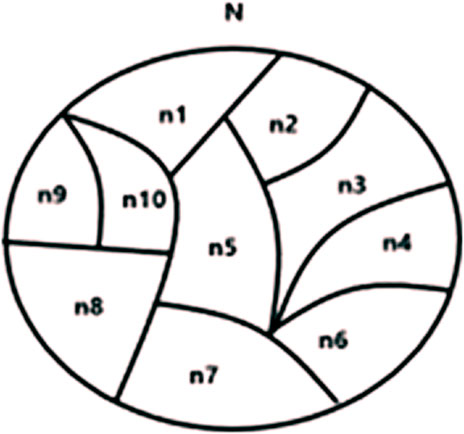
FIGURE 2. If the area chosen has a population of 5,000, the 10 strata must each have a population of about 500.
Each stratum should contain homogeneous units, i.e., similar types of dwellings; it may be an urban or rural area, a village, different neighborhoods of a city, a residential or commercial neighborhood, and an area with only condos or with contiguous or independent houses. It is important that the boundaries of each stratum are clearly defined (EUROSTAT, 2018).
Subdivision of the area may be performed using maps, such as satellite or street maps. The map should be as accurate as possible with a scale appropriate for the size of the area. An example of stratification is reported for the Giglio Island.
Giglio is a very small island with a population of about 1,500. It was divided into 10 strata with populations of about 150 each. The sat map (Figure 3) shows that there are about four residential areas and the rest of the island is rural. We first identified urban/rural strata; two rural areas (north and south) were identified.
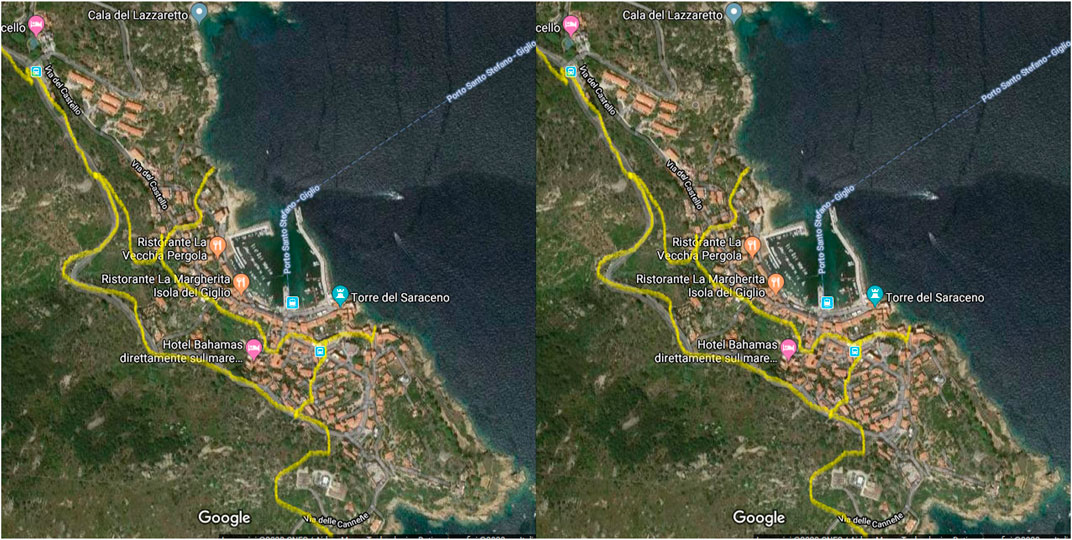
FIGURE 3. Identification of urban and rural areas of the Giglio Island and division of the urban area of Giglio Porto into four strata.
Then, each of the four urban areas was divided into a total of eight strata. The example of Giglio Porto divided into four strata is shown in Figure 3.
The next step was the selection of addresses by systematic sampling, independently for each stratum. The final sample chosen for each site involved about 200 interviews; to allow for nonresponses, we doubled the sample size. A total of 400 addresses were selected, i.e., 40 addresses per stratum. So for an area with a population of about 5,000, 500 per stratum, we had to select roughly one in every five addresses.
The next step was choosing a starting point for the selection of addresses. Once the first address in a stratum is chosen, the person doing the fieldwork has to cover all the streets of the stratum on foot, selecting one address in every five addresses (e.g., Figure 4, left side). Different paths are possible, as shown in Figure 4, right side.
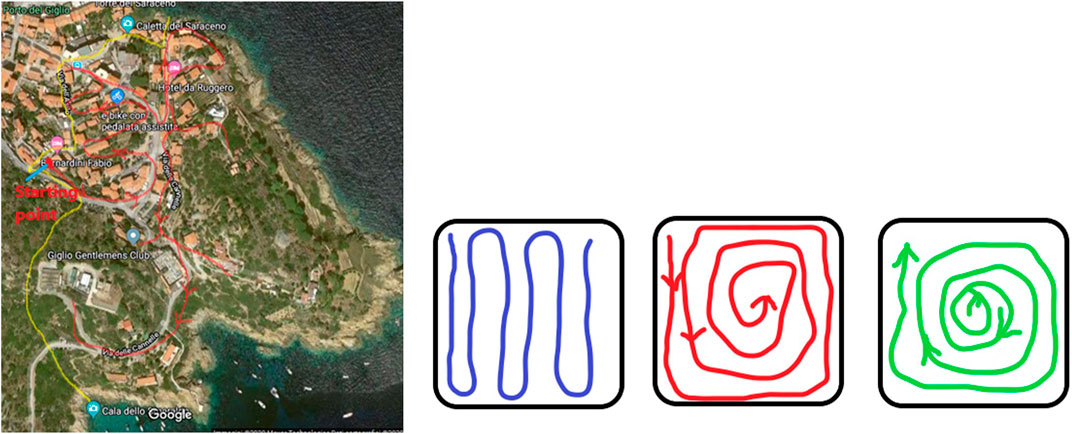
FIGURE 4. Example of a path for a stratum of the Giglio Island and examples of different paths that could be chosen for the same area.
Each address that was selected was recorded on a template database with the name of the family that appeared at the location and the full address. A letter was left in the mailbox of the selected family, informing its members about the survey and that an interviewer would contact them in the following days.
After this step, the fieldwork began. Trained and supervised interviewers with official badges visited the selected addresses and conducted computer-assisted personal interviews. To enhance response rates, the interviewers behaved as suggested by Hox and Leeuw (2002): 1. appear trustworthy; 2. appear friendly; 3. adapt to the situation at the doorstep; 4. react to the respondent.
A template with the full list of selected addresses and names of the families was provided to the interviewers. On the template, the interviewers recorded the outcome of the interviews as follows: interview completed, interview rejected, and family not present. In the latter case, the interviewer tried to contact the family three times at different hours and on different days: once in the morning, once in the evening, and once on the weekend. If the family was never found, it was recorded as ‘not present.’
3 Results and discussion
The survey was conducted in 12 Mediterranean locations: Civitavecchia (IT), Giglio Island (IT), Livorno (IT), Valencia (ES), Granada (ES), Malta (MT), Crete (GR), Durres (AL), Larnaca (CY), Ciovo Island (HR), Dubrovnik (HR), and Koper (SI). The sample size was about 200 units per area; at the end of the fieldwork, 2,843 answers had been collected (Table 1).
Respondents were nearly equally distributed by gender and quite similarly by age classes (32% 18–39 years, 38% 40–59, and 28% over 60); 48.5% worked but not in the maritime industry, nearly 39% did not work, and about 13% worked in the maritime industry.
Regarding respondent awareness of climate change issues, 65% were aware and believed something needed to be implemented; this percentage was higher for young respondents, confirming a known trend: young people are more susceptible to climate change concerns. Surprisingly, respondents who worked in the maritime industry scored the lowest awareness of climate change issues.
Regarding the environmental impact of current use and production of energy, two-thirds of respondents believed it is necessary to reduce household energy consumption and to produce energy from renewable resources in order to reduce environmental impact, while one-quarter of respondents only believed it is necessary to produce energy from renewable resources.
Regarding knowledge and perceptions of blue energy among respondents, more than half did not know about marine renewable energy. The percentage was higher among women, about two-thirds of whom did not know about blue energy. Again, a higher percentage of young respondents knew about blue energy, confirming their higher awareness of this topic.
Then, a set of five blue energy technologies was proposed to respondents, and their support for such installations was investigated: 1. a floating wind turbine to harness wind energy; 2. submarine kites to harness the energy of marine currents; 3. an oscillating water column plant installed on a pier to harness wave energy; 4. a set of floaters fixed to a pier to harness wave energy; 5. a cluster of oscillating buoys to harness the energy of waves offshore (see Figure 5).
All the technologies found strong support (Figure 6), especially the oscillating water column plant installed on a pier. They also considered this installation the least invasive.
The two preceding results showed that there could be a visual impact issue concerning support for blue energy installations. The next question investigated this point. Five issues of blue energy installations were suggested to respondents: noise, impact on fauna and flora, visual impact, negative effects on tourism, and negative effects on fishing. All issues were chosen by nearly half the respondents. The highest concern was the impact on fauna and flora (54%), followed by negative effects on fishing (52%), noise (49%), visual impact (47%), and negative effect on tourism (40%); no significant differences were found between males and females.
The last question concerned hopefulness about the positive effect of BE installations. Here, the five options presented to respondents were new jobs, energy independence, climate change mitigation, reduction of local pollution, and impetus for innovative start-ups. Quite strong expectations were found for all: nearly 77% were hopeful about new jobs and energy independence, and about two-thirds of respondents were hopeful about climate change mitigation, reduction of pollution, and innovative start-ups.
Results of the present survey cannot be directly compared with results of other similar studies because different sampling methods and questionnaires were developed and adopted. Nevertheless, lessons learned can be compared and drawn. Lange and Cummins (2021) suggested the need to find a proper framework closer to local communities to accommodate large infrastructure development. In this light, the survey implemented by the BLUE DEAL project could be read as an example of the involvement of local and coastal communities in the decision-making process to be widely replicated. Findings of Howell (2019) for Scotland (United Kingdom) are on the same line, describing that blue energy technologies that were perceived as a positive benefit for local areas were welcomed by local communities. One of the questions included in the BLUE DEAL questionnaire is devoted to understanding which technology is the most preferred, thus demonstrating that focusing on the opinion of citizens is considered the starting point for energy planning. Billing et al. (2022) investigated the public perception of a peculiar integration between blue energy technologies and fish farming in Italy and Scotland (United Kingdom). Nevertheless, their main findings confirm the importance of correct information about the local communities and their involvement as a milestone to have a positive reply from the citizens. Devine-Wright (2011), de Groot and Bailey (2016), and Brandt (2021), assessing the public perception of blue energy technology in Oregon (United States), Ireland (IE), and the United Kingdom, highlighted the role of the communities’ perception of local landscape value as one of the drivers for acceptance of blue energy. The BLUE DEAL questionnaire indirectly addressed this issue by asking citizens which technology is felt as less invasive, thus recognizing the importance of the preservation of the local landscape as of fundamental importance. Hazboun and Boudet (2020) carried out a comparative study to understand the public opinion and preference across a broad suite of energy sources, including both renewable and nonrenewable resources in British Columbia, Canada, and Washington and Oregon, United States. Even though the main aim of their research was broader than the survey carried out in the BLUE DEAL project, their main finding is aligned with the lesson learned by the BLUE DEAL project. In fact, as a final recommendation for policymakers, the authors stressed the importance of raising awareness and community involvement during the planning process.
Even a numerical comparison among the results obtained by the BLUE DEAL project for the Mediterranean countries and other studies and territories was not possible. Lessons learned and the main outcomes demonstrated the alignment of general findings and recommendations.
3.1 The portal
The site http://askyourcitizenonbe.unisi.it, which publishes the results, is an important product of the survey. An interface with the site includes one- and multi-dimensional statistical indicators and data processing using artificial intelligence techniques. The results are reported in the specific dashboard section with the details of the 12 sites. A data section by the macro-area is included in the dashboard. There is a “BUILD MY GRAPHS” section for a dynamic database. The tools for the main statistics and synthesis of the results for each location have a graphic interface, including a freely downloadable pdf.
The dashboard section was designed to be as simple as possible with predisposed processing and custom graphic options. On the first page (Figure 7), the first main overall statistics are available, such as the number of respondents and the percentage of respondents who were aware of climate change and believe something needs to be implemented. Users simply click symbols such as those shown in Figure 8.
Although the overall statistics appear on the first page of the dashboard, the site is designed to have the same graphs at site and area levels.
It is also possible to create selected short reports ad hoc at overall, site, or area levels and to download them in the pdf format. There is also an option to create a standard report with graphs at an aggregate level for each section (Figure 9).
The online dashboard is designed so that users can create graphs and perform selected analyses. In the section MyDashboard (e.g., Figure 10), it is possible to build all sorts of charts and double-entry tables. Users can even group sites or create customized areas and download all the reports. With a single click, all the graphs of the answers to the entire questionnaire can be visualized at the same time. There is also the possibility to analyze the correlation between two variables with double-entry tables: the user simply chooses the question of interest (select), grouping it (group by) by variable to find correlations, and the result is a graph made up of as many bar graphs as there are characteristics of the second variable. All analyses can be downloaded in the pdf format.
4 Conclusion
This study presents the empirical results of a survey on the general public’s perceptions and attitudes toward blue energy technologies in nine regions involved in the BLUE DEAL project. The results underline that a small majority of respondents do not know what blue energy is, albeit with differences according to the target site. However, although citizens were relatively unaware of blue energy, respondents were generally favorable to the installation of technologies to harness marine energy. Of the five technologies mentioned, oscillating water columns installed in piers were the most widely accepted, followed by oscillating buoys. Regarding concerns about the possible installation of one or more blue energy plants in their area, respondents expressed concern about all the impacts investigated, especially the impact on flora and fauna. Regarding local opportunities that the implementation of blue energy technologies could offer, respondents were hopeful about new jobs and energy independence.
To a certain extent, this survey in the first phase of the BLUE DEAL project tackled all the main aspects highlighted by the European Commission in its communication regarding strategies to harness potential offshore renewable energy for a climate-neutral future (EC, 2020). Indeed, it exemplifies the involvement of local people from the very start of energy planning with new technologies.
The results of the survey are an instrument to enable policymakers to obtain more knowledge on public perception of blue energy, set up concrete actions for developing blue energy in the Mediterranean area, and reach a wider audience. The scientific approach used to implement the survey showed that citizens are willing to participate in local planning and be involved in the energy transition from the earliest stages. In other words, the implementation of the survey put the social dimension of sustainability into practice. The social dimension is key to the success of any policy aimed at environmental sustainability.
The survey implemented in the framework of the BLUE DEAL project and the creation of the digital platform will allow other policymakers to implement the questionnaire in their regions of interest, increasing the dots on the Mediterranean map and making it possible to map Mediterranean citizens’ perceptions of blue energy.
Data availability statement
The datasets presented in this study can be found in online repositories. The names of the repository/repositories and accession number(s) can be found at: http://askyourcitizenonbe.unisi.it/dashboard/Aindex.php?F=fase1&VAR=T&TYPEVAR=TOTAL.
Author contributions
All authors listed have made a substantial, direct, and intellectual contribution to the work and approved it for publication.
Funding
The study was conducted in the framework of the Interreg Med BLUE DEAL (2019–2022) project, co-financed by the European Regional Development Fund and the Instrument for Pre-Accession Assistance Fund. Website: https://blue-deal.interreg-med.eu.
Conflict of interest
The authors declare that the research was conducted in the absence of any commercial or financial relationships that could be construed as a potential conflict of interest.
Publisher’s note
All claims expressed in this article are solely those of the authors and do not necessarily represent those of their affiliated organizations, or those of the publisher, the editors, and the reviewers. Any product that may be evaluated in this article, or claim that may be made by its manufacturer, is not guaranteed or endorsed by the publisher.
References
Agnew, S., Kopke, K., Power, O. P., Troya, M. D. C., and Dozier, A. (2022). Transdisciplinary research: Can citizen science support effective decision-making for coastal infrastructure management? Front. Mar. Sci. 9, 809284. doi:10.3389/fmars.2022.809284
Bastianoni, S., Praticò, C., Damasiotis, M., and Pulselli, R. M. (2020). Perspectives for marine energy in the mediterranean area. Front. Energy Res. 209. doi:10.3389/fenrg.2020.00209
Biermann, F. (2007). ‘Earth system governance’ as a crosscutting theme of global change research. Glob. Environ. Chang. 17 (3-4), 326–337. doi:10.1016/j.gloenvcha.2006.11.010
Billing, S. L., Charalambides, G., Tett, P., Giordano, M., Ruzzo, C., Arena, F., et al. (2022). Combining wind power and farmed fish: Coastal community perceptions of multi-use offshore renewable energy installations in Europe. Energy Res. Soc. Sci. 85, 102421. doi:10.1016/j.erss.2021.102421
Brandt, D. (2021). A current look at marine renewable energy in Oregon: Oregon MRE and the role of public perception and participation in Oregon's MRE future. [Master Thesis], Corvallis, OR: Oregon State University.
de Groot, J., and Bailey, I. (2016). What drives attitudes towards marine renewable energy development in island communities in the UK? Int. J. Mar. Energy 13, 80–95. doi:10.1016/j.ijome.2016.01.007
Devine-Wright, P. (2011). Place attachment and public acceptance of renewable energy: A tidal energy case study. J. Environ. Psychol. 31 (4), 336–343. doi:10.1016/j.jenvp.2011.07.001
Dhivagar, R., Shoeibi, S., Kargarsharifabad, H., Ahmadi, M. H., and Sharifpur, M. (2022). Performance enhancement of a solar still using magnetic powder as an energy storage medium‐exergy and environmental analysis. Energy Sci. Eng. doi:10.1002/ese3.1210
Djurisic, V., Smolovic, J. C., Misnic, N., and Rogic, S. (2020). Analysis of public attitudes and perceptions towards renewable energy sources in Montenegro. Energy Rep. 6, 395–403. doi:10.1016/j.egyr.2020.08.059
European Commission (2019a). Communication from the commission to the European parliament. Brussels: European Council, the CouncilFIN. the European Economic and Social Committee and the Committee of the Regions: The European Green Deal. Communication no. COM/2019/640. Brussels: European Commission. Available online at: https://eur-lex.europa.eu/legal-content/EN/TXT/?uri=COM:2019:640.
European Commission (2019b). Clean energy for all Europeans. Luxembourg: Publications office of the European Union.
European Commission (2020). Communication from the commission to the European parliament, the European council, the council, the European economic and social committee and the committee of the regions: An EU strategy to harness the potential of offshore renewable energy for a climate neutral future. Available at: https://eur-lex.europa.eu/legal-content/EN/TXT/PDF/?uri=CELEX:52020DC0741&from=EN.
European Commission 2021. Communication from the commission to the European parliament, the European council, the council, the European economic and social committee and the committee of the regions: Transforming the EU’s blue economy for a sustainable future. Available online at: EUR-Lex – COM:2021:240:FIN – EN – EUR-Lex (europa.eu)
EUROSTAT (2018). European social survey round 9 sampling guidelines: Principles and implementation. ESS Sampl. Weight. Expert Panel.
Fischer, B., Gutsche, G., and Wetzel, H. (2021). Who wants to get involved? Determining citizen willingness to participate in German renewable energy cooperatives. Energy Res. Soc. Sci. 76, 102013. doi:10.1016/j.erss.2021.102013
Gilani, H. A., Hoseinzadeh, S., Karimi, H., Karimi, A., Hassanzadeh, A., and Garcia, D. A. (2021). Performance analysis of integrated solar heat pump VRF system for the low energy building in Mediterranean island. Renew. Energy 174, 1006–1019. doi:10.1016/j.renene.2021.04.081
Goffetti, G., Montini, M., Volpe, F., Gigliotti, M., Pulselli, F. M., Sannino, G., et al. (2018). Disaggregating the SWOT analysis of marine renewable energies. Front. Energy Res. 138. doi:10.3389/fenrg.2018.00138
Hazboun, S. O., and Boudet, H. S. (2020). Public preferences in a shifting energy future: Comparing public views of eight energy sources in north America’s pacific northwest. Energies 13 (8), 1940. doi:10.3390/en13081940
Howell, R. J. (2019). In sight and in mind: Social implications of marine renewable energy. [PhD thesis]. Edinburgh (UK)]: The University of Edinburgh.
Hox, J., and De Leeuw, E. (2002). “The influence of interviewers attitudes and behaviour in household non-response,” in Survey nonresponse. Editors R. Groves, D. Dillman, J. Eltinge, and R. Little (London: Wiley).
Jaenson, R., Bassuk, N., Schwager, S., and Headley, D. (1992). A statistical method for the accurate and rapid sampling of urban street tree populations. J. Arboric. 18 (4), 171–183.
Karasmanaki, E., and Tsantopoulos, G. (2021). Public attitudes toward the major renewable energy types in the last 5 years: A scoping review of the literature. Low. Carbon Energy Technol. Sustain. Energy Syst., 117–139. doi:10.1016/B978-0-12-822897-5.00004-3
Lange, M., and Cummins, V. (2021). Managing stakeholder perception and engagement for marine energy transitions in a decarbonising world. Renew. Sust. Energy Rev. 152, 111740. doi:10.1016/j.rser.2021.111740
Lennon, B., Dunphy, N. P., and Sanvicente, E. (2019). Community acceptability and the energy transition: A citizens’ perspective. Energy Res. Soc. Sci. 9, 35. doi:10.1186/s13705-019-0218-z
Macht, J., Klink-Lehmann, J. L., and Simons, J. (2022). German citizens’ perception of the transition towards a sustainable bioeconomy: A glimpse into the rheinische revier. Sustain. Prod. Consump. 31, 175–189. doi:10.1016/j.spc.2022.02.010
McMichael, J., Shook-Sa, B., Ridenhour, J., and Harter, R. (2013). “Chum: A frame supplementation procedure for address-based sampling,” in Fed. Comm. Stat. Methodol. Res. Conf. Washington. D.C, November 4, 2013.
O'Connor, C. D., Fredericks, K., and Kosoralo, K. (2022). People's perceptions of energy technologies in an era of rapid transformation. Environ. Innov. Soc. Trans. 43, 331–342. doi:10.1016/j.eist.2022.04.010
Peterson, T. R., Stephens, J. C., and Wilson, E. J. (2015). Public perception of and engagement with emerging low-carbon energy technologies: A literature review. MRS Energy Sustain 2. doi:10.1557/mre.2015.12
Shoeibi, S., Ali Agha Mirjalily, S., Kargarsharifabad, H., Panchal, H., and Dhivagar, R. (2022a). Comparative study of double-slope solar still, hemispherical solar still, and tubular solar still using Al2O3/water film cooling: A numerical study and CO2 mitigation analysis. Environ. Sci. Pollut. Res., 1–17. doi:10.1007/s11356-022-20437-1
Shoeibi, S., Kargarsharifabad, H., Mirjalily, S. A. A., and Zargarazad, M. (2021). Performance analysis of finned photovoltaic/thermal solar air dryer with using a compound parabolic concentrator. Appl. Energy 304, 117778. doi:10.1016/j.apenergy.2021.117778
Shoeibi, S., Kargarsharifabad, H., Sadi, M., Arabkoohsar, A., and Mirjalily, S. A. A. (2022b). A review on using thermoelectric cooling, heating, and electricity generators in solar energy applications. Sustain. Energy Technol. Assess. 52, 102105. doi:10.1016/j.seta.2022.102105
Sütterlin, B., and Siegrist, M. (2017). Public acceptance of renewable energy technologies from an abstract versus concrete perspective and the positive imagery of solar power. Energy Policy 106, 356–366. doi:10.1016/j.enpol.2017.03.061
Tampakis, S., Arabatzis, G., Tsantopoulos, G., and Rerras, I. (2017). Citizens’ views on electricity use, savings and production from renewable energy sources: A case study from a Greek island. Renew. Sust. Energy Rev. 79, 39–49. doi:10.1016/j.rser.2017.05.036
Verma, V., Ghellini, G., and Betti, G. (2010). “Area sampling for small-scale economic units,” in Agricultural survey methods. Editors R. Benedetti, M. Bee, G. Espa, and F. Piersimoni (John Wiley & Sons, Ltd), 85–106.
Keywords: marine renewable energies (MREs), blue energy, citizen engagement, citizen perception, social acceptance
Citation: Betti G, Cervellera GP, Gagliardi F, Gioia C, Patrizi N and Bastianoni S (2022) Perceptions and attitudes toward blue energy and technologies in the Mediterranean area: ASKYOURCITIZENSONBE. Front. Energy Res. 10:973952. doi: 10.3389/fenrg.2022.973952
Received: 20 June 2022; Accepted: 14 September 2022;
Published: 02 November 2022.
Edited by:
Siamak Hoseinzadeh, Sapienza University of Rome, ItalyReviewed by:
Shahin Shoeibi, Islamic Azad University Semnan, IranCarlos Pérez-Collazo, University of Vigo, Spain
Amir Hassanzadeh, Urmia University, Iran
Ali Sohani, University of Rome Tor Vergata, Italy
Al-Janabi, Sultan Qaboos University, Oman
Copyright © 2022 Betti, Cervellera, Gagliardi, Gioia, Patrizi and Bastianoni. This is an open-access article distributed under the terms of the Creative Commons Attribution License (CC BY). The use, distribution or reproduction in other forums is permitted, provided the original author(s) and the copyright owner(s) are credited and that the original publication in this journal is cited, in accordance with accepted academic practice. No use, distribution or reproduction is permitted which does not comply with these terms.
*Correspondence: Nicoletta Patrizi, cGF0cml6aTJAdW5pc2kuaXQ=
 Gianni Betti
Gianni Betti Gian Piero Cervellera
Gian Piero Cervellera Francesca Gagliardi
Francesca Gagliardi Carmela Gioia
Carmela Gioia Nicoletta Patrizi
Nicoletta Patrizi Simone Bastianoni
Simone Bastianoni
